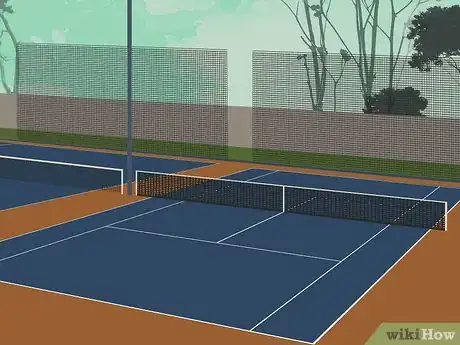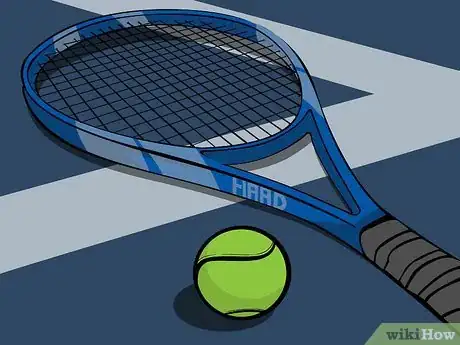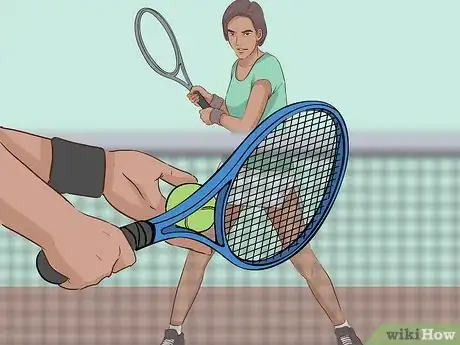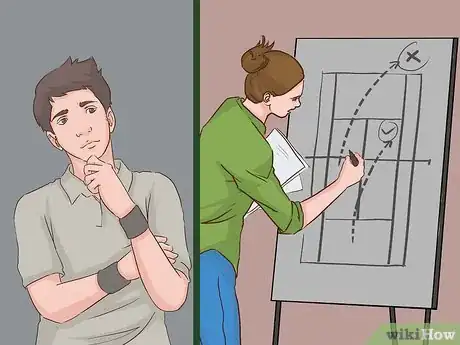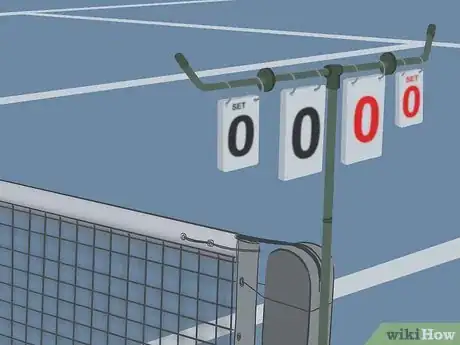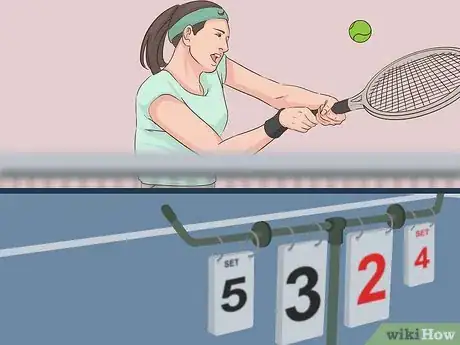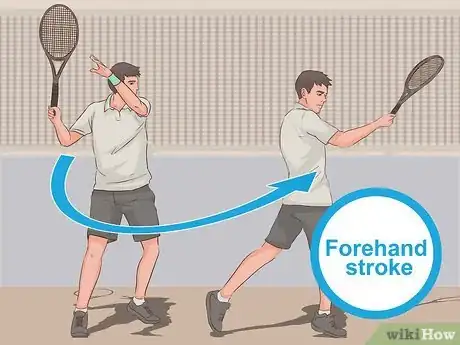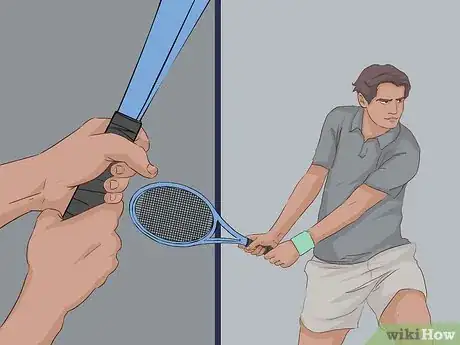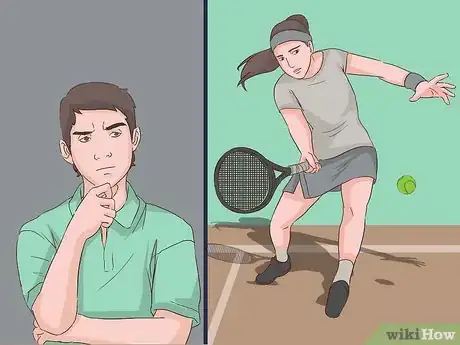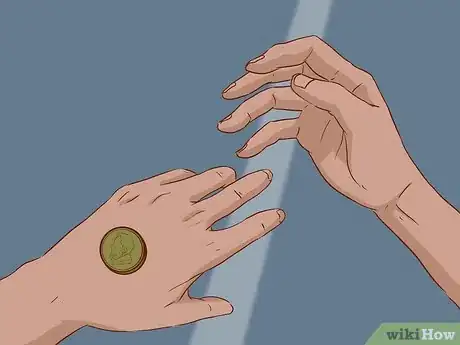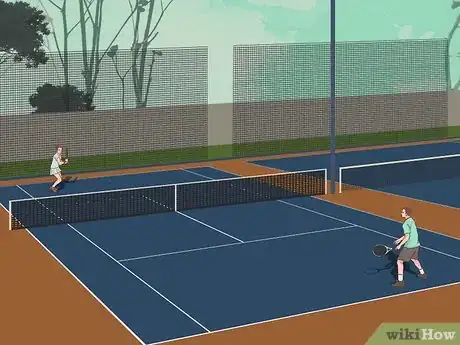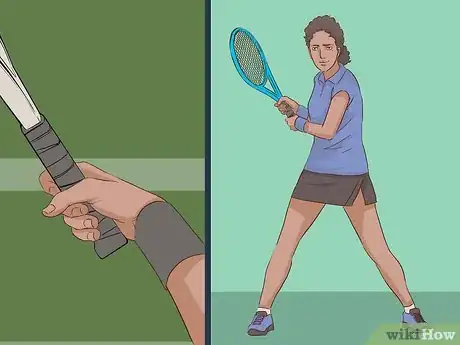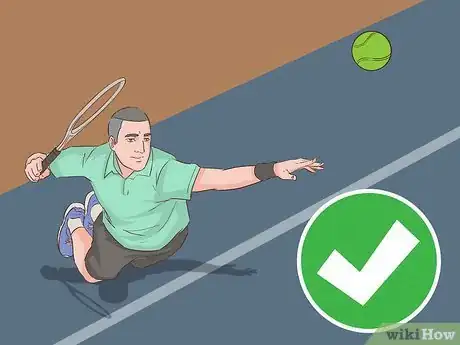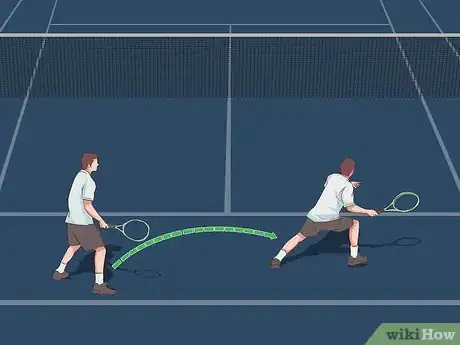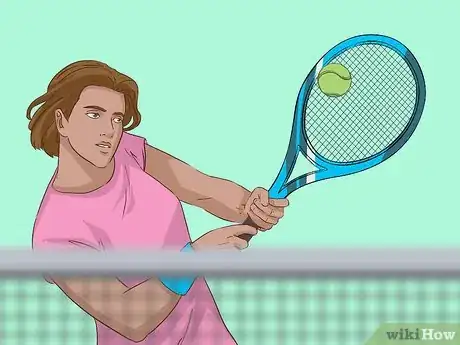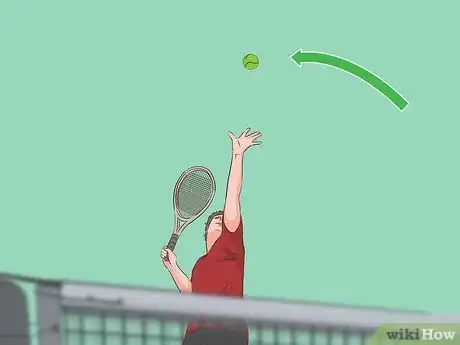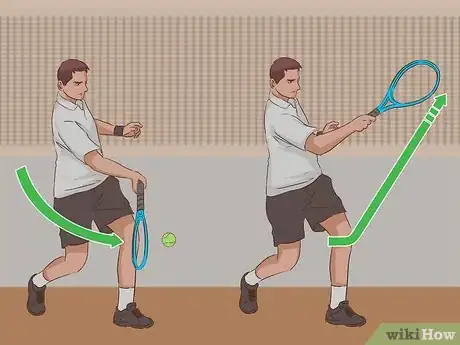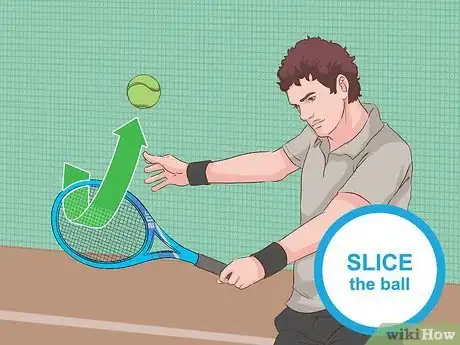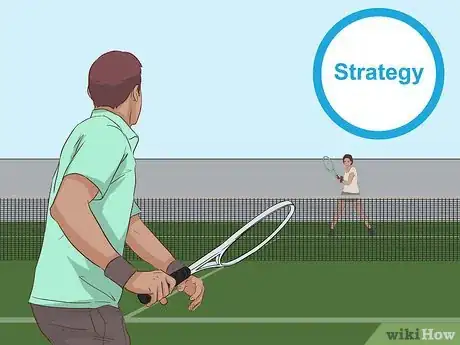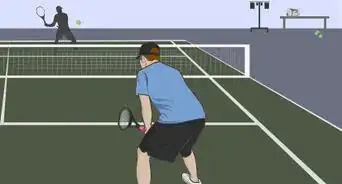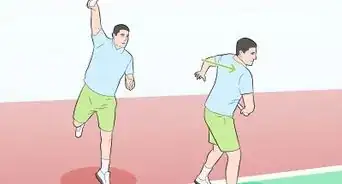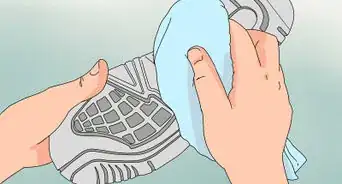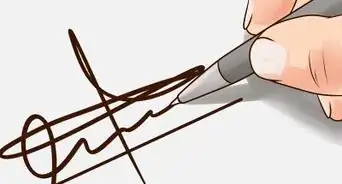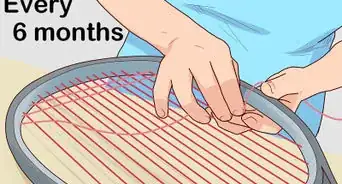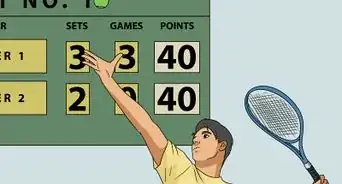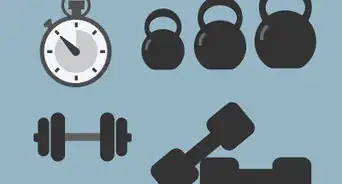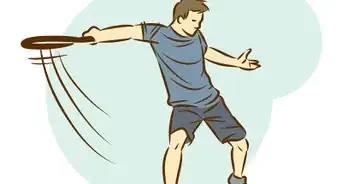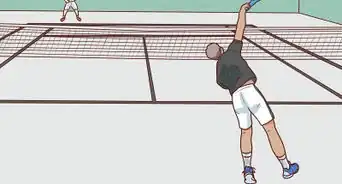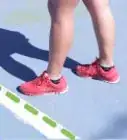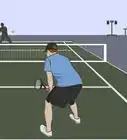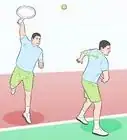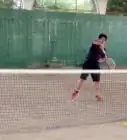This article was co-authored by Peter Fryer. Peter Fryer is a tennis writer and coach based in Derry Northern Ireland. He completed his professional teaching tennis qualification shortly after finishing university and has been teaching tennis for over 13 years. Peter began Love Tennis Blog in 2010 and contributes to the BBC and national media outlets.
There are 7 references cited in this article, which can be found at the bottom of the page.
wikiHow marks an article as reader-approved once it receives enough positive feedback. This article received 18 testimonials and 84% of readers who voted found it helpful, earning it our reader-approved status.
This article has been viewed 655,635 times.
Have you always wanted to learn to play tennis, but you've been unsure of where to start? Do you love watching Rafael Nadal or Serena Williams dominate the courts, and hope to be just like them? Playing tennis can help you build speed, power, and fitness. It's also a great way to spend time with your family or your friends. Learn the layout of the court, the scoring system, and all the playing techniques you need to become a tennis pro.
Steps
Getting Started
-
1Find a place to play. You can play tennis at your local park, a gym, or tennis club. Search online or ask friends where the best local courts are. Most parks let you play for free, but you'll probably need to pay membership fees to play anywhere else.[1]
- You can practice basic serving techniques in any large, open space, but it's best to spend as much time as possible on actual courts. You'll learn the layout of the court faster, and minimize the risk of breaking anything with your racquet or a ball!
-
2Buy tennis supplies. You don't need to buy professional-grade tennis supplies right away, but every beginner will need to have a few things to get started. Some gyms or tennis clubs provide basic supplies for their members, but if that isn't the case, you'll need to go shopping.[2]
- You'll need a racquet with its own case. For a beginner, all you really need to do is check to make sure your hand fits comfortably around the handle. The racquet shouldn't feel like it's too heavy to move, but it also shouldn't feel like it weighs nothing. There are also men's and women's racquets, but you should prioritize fit over gender in most cases.
- Buy at least three tennis balls. They get lost very easily!
Advertisement -
3Buy tennis clothes. Before you buy tennis clothes, ask your gym or club if they have any clothing requirements. If not, any loose, comfortable athletic clothes will be fine.
- Stricter clubs may require you to buy tennis shoes, tennis shorts and shirts, and tennis skirts for women. However, this is not always the case.
- Tennis shoes are the best to play tennis in, but if you don't have them, any pair of sneakers will do.
-
4Find an opponent. Once you learn the basics, you'll need an opponent to practice tennis with. Ask anyone you see playing at your local court if they'd be interested in helping you learn. If not, try asking friends, family, or even searching online for a local tennis association.[3]
Learning the Basics
-
1Learn about the parts of the court. Figuring out the different areas of the tennis court is the first step in learning how to play. Different parts of the court are better for different kinds of plays, so spend some time walking around the court before starting to practice.
- Tennis courts are divided in two by a net--one side is yours, the other is your opponent's. You can't touch the net or hit the ball into it in-game.
- The parallel line furthest from the net is the baseline. You'll stand here to make the first serve.
- There's a thinner line between the baseline and the net. This is the service line. You'll aim your serves into the area between the net and the service line.
- The small line in the middle of the baseline is the center mark. You'll stand to the left or right of this mark to serve.
- The service area is divided into vertical halves, perpendicular to the net. This divides the service area into left and right sections.
- The two lines on each side of the court perpendicular to the net mark the boundaries of the court. The inner line is for a singles game and the outer is for doubles.
-
2Learn the basics of tennis scoring. One player serves the ball per game. From the time the ball is served, one point is available to either player. The point is awarded when the ball goes out of bounds, hits the net, or is missed by a player. The game ends after one player has scored four points with a margin of at least two points over the loser. For example, a score of 4 - 2 means that the game is over, but a score of 4 - 3 means that the game must continue.
- Tennis games begin with zero points on each side. In tennis, a score of zero is called “love.”
- Scores are called at the beginning of each point serve. For a score of one, the announcer or server will call “fifteen.” For a score of two, the call is “thirty.” For a score of three, the call is “forty.” For a score of four or a winning score, the call is “game.”
- Each serve point is awarded to the player who doesn't let the ball hit the net, bounce twice, or go out of bounds. Each of these actions ends the point.
- "Breaking the serve" occurs when the player who didn't serve wins the game.
-
3Play all your practice games in sets. Tennis is played in sets--you don't just play one game and then go home! Sets consist of at least six games. The set doesn't end until one player wins six games and has a margin of two wins over their opponent. For example, if one player has won six games and the other has won five, they'll have to keep playing until the winner has two more wins than the loser.
- If both players win six games each, a tie breaking game is usually called.
- Tennis matches usually consist of three or five sets.
-
4Practice hitting the ball with your racquet. Before you start actually serving or playing, get used to your racquet and ball. Practice tossing the ball in the air and hitting it until you can hit the ball hard a few times in a row. Don't worry too much about accuracy right now--just get a feel for your racquet and a feel for the ball.
-
5Learn how to do a forehand stroke. The forehand stroke is played by holding the racquet out in your dominant hand, like you're shaking hands with it. Then, pivot so that you wind the racquet behind you and hit the ball outward and upward. This stroke is best for softer, higher serves.[4]
-
6Try a backhand stroke. The backhand is one of the easiest strokes to master. Grip the racquet with both hands and hold it out to the side. It should look similar to a baseball player at bat. When the ball approaches, hit it hard at a slight upward angle. This stroke hits the ball hard and is a great way to be sure that your ball will get into the service area.[5]
- There is also a one-handed backhand stroke. You use your dominant hand only, but everything else stays the same. This one is a little tougher to manage.
-
7Learn how to volley. Volleying is a way to return a low serve. There are two kinds of volleys--forehand and backhand. In the forehand volley, you'll hold the racquet in your dominant hand with the back of your hand facing the baseline. Simply lean in low towards the ball and hit it.[6]
- The backhand volley is performed in a similar way, except the back of your hand faces the net. The motion in a backhand volley is similar to elbowing someone out of the way while crouching.
Playing a Game
-
1Flip a coin to choose a server. In tennis, one person starts the first serve of the game. Most players choose by flipping a coin, and in most cases, the person who doesn't serve gets to choose which side of the court to play on. The server keeps serving until the game ends. For the next game, the other player will serve.[7]
-
2Position yourself in a baseline corner. The game starts with both players on the baseline. The server chooses a corner of the baseline to serve from, and the other player positions themselves on the opposite back corner. So if you serve from the right corner of your side of the court, your opponent will stand in the far left corner from your point of view.[8]
- You should be standing facing the opposite corner. Keep one foot slightly above the baseline and the other about 45 centimetres (18 in) away inside the court.
-
3Hold your racquet out. There isn't a required way to hold the racquet as long as your hand is around the handle. Grip the racquet firmly in your dominant hand and hold it out with your arm extended, until the head of the racquet is roughly parallel with your head.
- When you aren't serving, you can hold the racquet with both hands. Usually, the dominant hand will grip the top of the handle with the other hand at the bottom, but there's no required position as long as you keep your hand or hands on the handle only.
-
4Throw the ball into the air with your opposite hand. If you're serving, toss the tennis ball into the air towards your racquet. It's okay to toss the ball around a few times without using your racquet or to bounce it on the court before beginning your official serve. Get used to the ball and how it handles before you serve.[9]
- If you want to do a practice toss, don't hit it with your racquet. This counts as a fault, which could give your opponent a point! Save practice hits for non-game times.
- If you aren't serving, continue holding your racquet and waiting.
-
5Serve the ball towards the service area. When the ball approaches the head of your racquet, strike it hard diagonally towards the other player's service area. Aim towards the section of the service area closes to them. The idea is to force the ball to bounce once before they can return the serve.[10]
- If the ball hits the net on the way to the other side of the court, it's called a “let” and you can do the serve over again.
- If the ball stays on your side of the court, goes out of bounds, or if you miss the serve altogether, it's a “fault.” You can get one do-over for a fault, but if you fault twice in one serve, the point is awarded to your opponent and the game moves on to the next point.
-
6Run to the opposite back corner and hit the ball back. Immediately after you serve the ball, run to the opposite side of your baseline. Hit the ball firmly with the face of your racquet pointed slightly upward. It takes some practice to learn how to return the serve successfully, so don't worry if you do badly the first few times.[11]
-
7Continue until the point is won. The point is only awarded when the ball falls out of play, so keep playing until one of you wins a point! Points can last anywhere from a few seconds to several minutes, but as a beginner, your points will probably be awarded quickly.
- When the point is awarded, you'll call the score and serve again until the game is won, and then again until the set is won.
Practicing Advanced Techniques
-
1Hit an overhead return. An overhead return is a shot where the other player lobs the ball up high over your head, and you aim to slam it down on his side so it's nearly impossible to return. Wait until you're served with a very high ball to try this one--it won't work on a normal serve.[12]
- Hold your racquet back behind your head so it grazes your back.
- When the ball is almost over your head, slam it down with the racquet over the net, just as you would do with a serve. Aim towards the opposite side of the court from your opponent.
- You can also do an overhead serve by performing the same actions while serving.
-
2Put topspin on your strokes. Adding topspin to your strokes can help the ball bounce higher and move faster. Don't hit the ball head-on to the center of your racquet like you usually would.
- Use your racquet to hit the side of the ball.[13]
- Immediately after you hit the side of the ball, move the racquet upwards and strike the top of the ball. This makes the ball spin in an upward arc instead of moving in a straight path.
-
3Learn to slice the ball. Slicing the ball allows you to change the direction of the ball and to slow it down enough to make it lose enough momentum so that it stops on your opponent's court before they have a chance to get to it.[14]
- To slice the ball, hit it from underneath first.
- Then, immediately bring the racquet forward towards your opponent's side. This will slow the ball down as it approaches, making your opponent more likely to miss.
-
4Learn to play on different surfaces. There are several different kinds of surfaces you can play tennis on, and each can affect your playing speed and abilities. Learning to master tennis on multiple surfaces can help you improve your game significantly.[15]
- Hard surfaces like asphalt and acrylic are most common in North America. They tend to be good for beginners because the surface allows for more bounces, but they can be hard on players' joints.
- Clay surfaces are most common in Europe and Latin America, and they tend to make the gameplay slower. The ball also bounces highest on a clay court.
- Grass courts are the kind used at Wimbledon. Grass court games tend to be very fast, since the ball bounces less and the player is more likely to miss a serve.
-
5Read your opponent's strategy. As you get better at tennis, you'll learn how to study your opponent and use their own strategies and preferences against them. This is a skill that takes a lot of time to develop, so don't worry if you can't do it right away.[16]
- Many players, especially beginners, are most comfortable with one specific stroke. If you notice that your opponent likes to strike the ball high with a forehand motion, you can learn to serve them low balls that require a backhand motion.
- Many players either love or hate playing close to the net. Figure out how your opponent feels about playing near the net. If they spend most of their time on the baselines, serve the ball close to the net to force them up there.
- Get to know your opponent's serve. Every player has their own serving style. If your opponent always serves the ball in the same direction at the same height, make sure you're standing there to return the serve!
- Study your opponent's mental state. A stressed or upset opponent is a vulnerable opponent. If they're reacting angrily, missing easy shots, or don't seem to be paying attention to the game, you can leverage that into a win by serving a variety of shots to confuse them.
-
6Learn to play doubles tennis. Doubles tennis has two players on each side instead of one. You'll use the wider court dimensions, but the rest of the scoring and rules remain the same. The big challenge for doubles tennis beginners is to learn how to interact with a teammate. Ask other tennis-playing friends to teach you the best strategies for doubles tennis.[17]
- There's also a variety called Canadian doubles, in which one team has two players and the other only one. It's usually played in situations where the single player is far more advanced than the doubles.
Expert Q&A
Did you know you can get expert answers for this article?
Unlock expert answers by supporting wikiHow
-
QuestionWhat kind of conditioning will help me play tennis better?
 Peter FryerPeter Fryer is a tennis writer and coach based in Derry Northern Ireland. He completed his professional teaching tennis qualification shortly after finishing university and has been teaching tennis for over 13 years. Peter began Love Tennis Blog in 2010 and contributes to the BBC and national media outlets.
Peter FryerPeter Fryer is a tennis writer and coach based in Derry Northern Ireland. He completed his professional teaching tennis qualification shortly after finishing university and has been teaching tennis for over 13 years. Peter began Love Tennis Blog in 2010 and contributes to the BBC and national media outlets.
Tennis Instructor
-
QuestionI'm worried that I'm not fit enough for tennis?
 Peter FryerPeter Fryer is a tennis writer and coach based in Derry Northern Ireland. He completed his professional teaching tennis qualification shortly after finishing university and has been teaching tennis for over 13 years. Peter began Love Tennis Blog in 2010 and contributes to the BBC and national media outlets.
Peter FryerPeter Fryer is a tennis writer and coach based in Derry Northern Ireland. He completed his professional teaching tennis qualification shortly after finishing university and has been teaching tennis for over 13 years. Peter began Love Tennis Blog in 2010 and contributes to the BBC and national media outlets.
Tennis Instructor
-
QuestionI'm worried tennis isn't going to make me lose enough calories
 Peter FryerPeter Fryer is a tennis writer and coach based in Derry Northern Ireland. He completed his professional teaching tennis qualification shortly after finishing university and has been teaching tennis for over 13 years. Peter began Love Tennis Blog in 2010 and contributes to the BBC and national media outlets.
Peter FryerPeter Fryer is a tennis writer and coach based in Derry Northern Ireland. He completed his professional teaching tennis qualification shortly after finishing university and has been teaching tennis for over 13 years. Peter began Love Tennis Blog in 2010 and contributes to the BBC and national media outlets.
Tennis Instructor
Warnings
- If your elbow, forearm, or wrist is sore after playing tennis, put an icepack on the sore spot to ease the pain. Avoid playing for a day or so to give the tendons time to recover.⧼thumbs_response⧽
Things You'll Need
- Tennis court
- Tennis racquet
- Racquet case
- Tennis balls
- Opponent
- Tennis partner (if playing doubles)
References
- ↑ https://www.theguardian.com/lifeandstyle/2009/jun/28/learn-to-play-tennis
- ↑ http://www.ducksters.com/sports/tennisgameplay.php
- ↑ https://www.theguardian.com/lifeandstyle/2009/jun/28/learn-to-play-tennis
- ↑ http://www.active.com/tennis/articles/how-to-play-tennis-tips-for-beginners
- ↑ http://www.active.com/tennis/articles/how-to-play-tennis-tips-for-beginners
- ↑ http://www.active.com/tennis/articles/how-to-play-tennis-tips-for-beginners
- ↑ https://www.theguardian.com/lifeandstyle/2009/jun/28/tennis-learn-serves-strategies
- ↑ http://www.ducksters.com/sports/tennisgameplay.php
- ↑ http://www.active.com/tennis/articles/how-to-play-tennis-tips-for-beginners
- ↑ http://www.active.com/tennis/articles/how-to-play-tennis-tips-for-beginners
- ↑ http://www.active.com/tennis/articles/how-to-play-tennis-tips-for-beginners
- ↑ https://www.theguardian.com/lifeandstyle/2009/jun/28/tennis-learn-serves-strategies
- ↑ https://www.theguardian.com/lifeandstyle/2009/jun/28/tennis-learn-serves-strategies
- ↑ https://www.theguardian.com/lifeandstyle/2009/jun/28/tennis-learn-serves-aces
- ↑ http://sportsbyapt.com/types-tennis-courts/
- ↑ http://www.active.com/tennis/articles/how-to-play-tennis-tips-for-beginners
- ↑ http://www.tennistips.org/how-to-play-tennis.html
About This Article
Tennis is a fun, fast-paced sport where opponents hit a tennis ball back and forth over a net in order to score points. To get started, 2 players get set up on opposite sides of the tennis court with the net in between them. Flip a coin or decide which player will serve the ball for the first game. For the next game, the other player will be the server. The server chooses a corner of the baseline to serve from, and the other player positions themselves on the opposite back corner. The server holds their racquet in their dominant hand, tosses the tennis ball up into the air, and strikes the ball hard, aiming diagonally towards the other player's service area. The idea is to force the ball to bounce once before your opponent can return the serve. If the ball stays on the server’s side of the court or goes out of bounds, it's a “fault.” The server gets one do-over for a fault, but if you fault twice in one serve, a point is awarded to your opponent. Immediately after you serve the ball, run to the opposite side of your baseline so you can hit the ball back to your opponent after they return your serve. Hit the ball firmly with the face of your racquet pointed slightly upward. Remember, the ball has to bounce once on the other side of the net before your opponent hits it! Players continue to volley the ball back and forth until someone scores a point. A point is awarded when the ball goes out of bounds, hits the net, or is missed by a player. The game ends when a player scores 4 points and leads with a margin of at least 2 points over the loser. For example, a score of 4 - 2 means the game is over, but a score of 4 - 3 means the game must continue. Once the game is over, the other player takes their turn as the server and gameplay continues. Tennis is played in sets and a set consists of at least 6 games. The set doesn't end until 1 player wins 6 games and has a margin of 2 wins over their opponent. If both players win 6 games each, a tie breaking game is usually called. If you want to play a full tennis match with your opponent, you’ll play 3-5 sets. To learn how to do different strokes, like a backhand stroke, keep reading.
